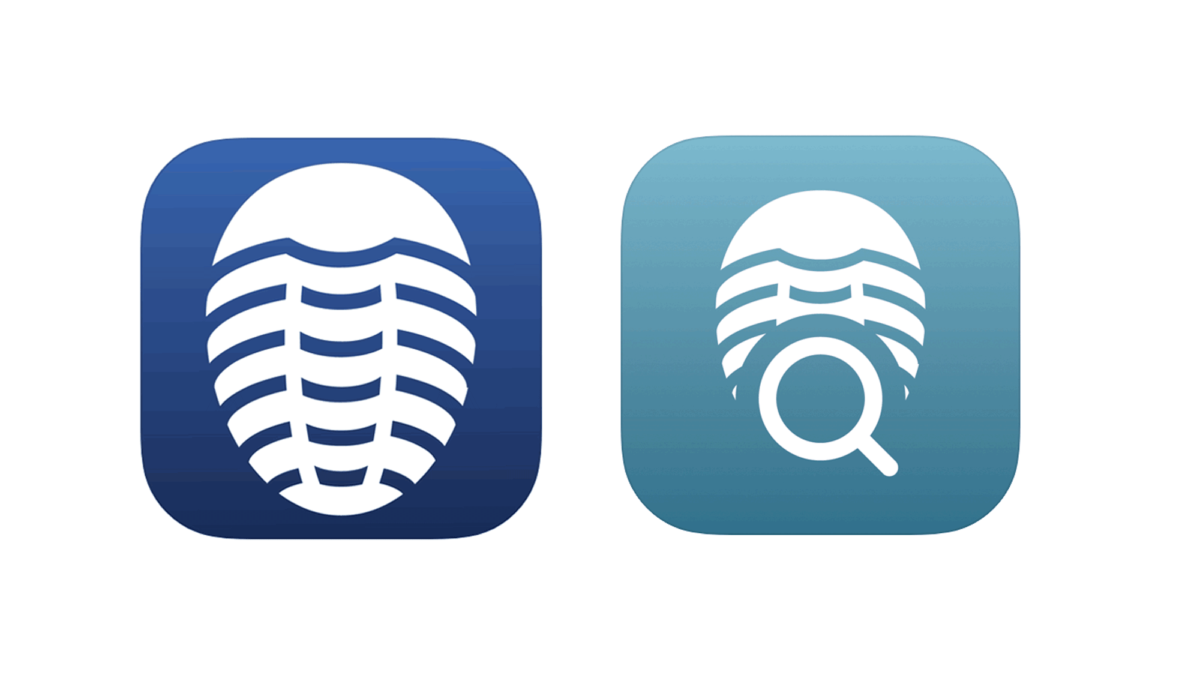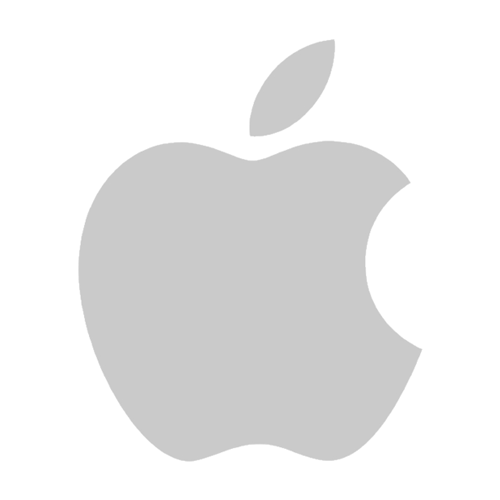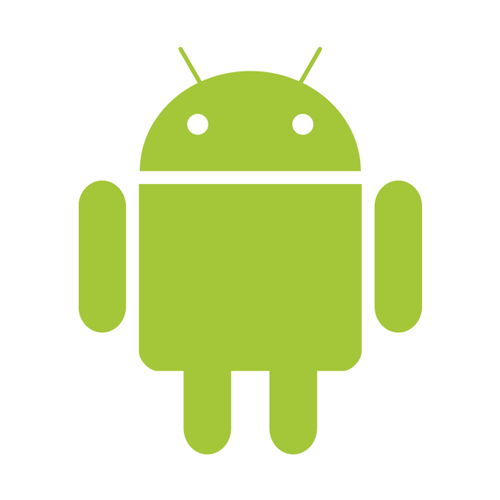As part of the Digital Atlas of Ancient Life project, we have developed two apps to help you identify and learn about fossils: the Digital Atlas of Ancient Life App and the Digital Atlas Identify App. Each is described below.
Digital Atlas of Ancient Life App
The Digital Atlas of Ancient Life App takes the content from the web versions of the Digital Atlases of Ancient Life fossil field guides and translates it to those handheld devices humans seem to be increasingly tethered to: our smart phones.
The creators of the Digital Atlas of Ancient Life recognized that the general public and educators might sometimes want to identify fossils in the field, where they likely don't have wi-fi or cell service. The Digital Atlas of Ancient Life App was developed to address this problem.
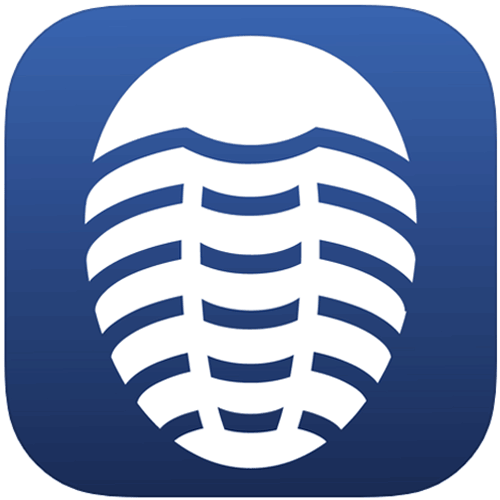
The App provides a version of the content available online, but abridged and adapted for what computer folks refer to as the ‘handheld device environment.’ On the App, images of species are available just as with the online version, split up by taxonomic category starting at the level of phylum. Options are available to browse groups of species as well; the maps that are available on the App are somewhat more detailed than those in the online version.
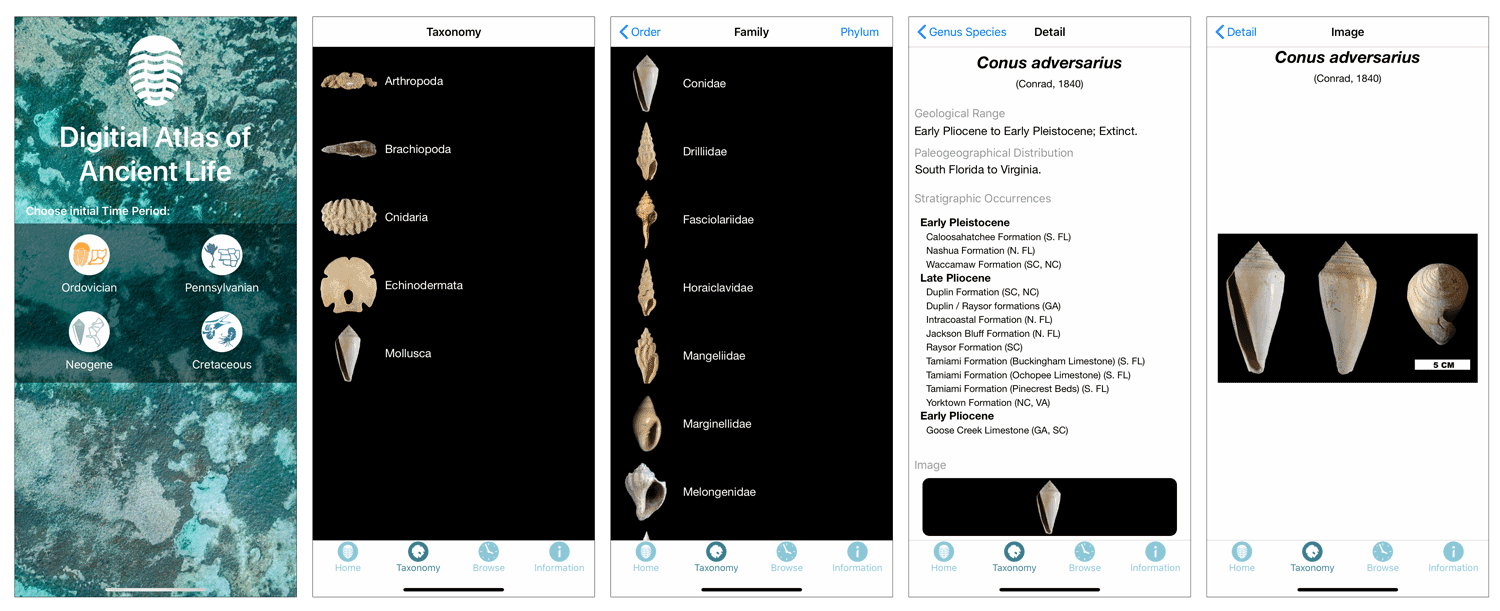
Screenshots from the Neogene portion of the Digital Atlas App.
Further, the App provides content for major groups of invertebrate fossils from four major time periods and geographic regions in the United States: the Ordovician of the Cincinnatian region, the Pennsylvanian of the Mid-Continent, and the Neogene of the southeast, as well as invertebrate and vertebrate groups for the Cretaceous of the American Midwest and High Plains, just as the website provides.
The App is free and available for both iOS (iPhone and iPad) and Android devices.
The development of the Digital Atlas App was supported by National Science Foundation grants through the Emerging Frontiers and Advancing the Digitization of Biological Collections programs that created the PALEONICHES – Thematic Collections Network (TCN) and the Cretaceous World TCN, respectively. It was programmed by Rod and Zach Spears of Lawrence, KS.
Images of species and information about their distribution comes from collections at the American Museum of Natural History, the Cincinnati Museum Center, the Fort Hays State University, the Miami (Ohio) University, the Ohio Univesity, the Paleontological Research Institution, the South Dakota School of Mines & Technology, the University of Colorado, the University of Florida, the University of Kansas, the University of New Mexico, the University of Texas, and Yale University.
For media interviews and stories about the Digital Atlas App check out:
Articles
Stories are listed newest to oldest.
Meisenholder, J. 2021. "Why fossil hunting is the next big hobby—seriously," The Wall Street Journal, 24 March 2021. Article about fossil collecting that calls the Digital Atlas app "The best fossil identification app."
Grimmet, B. 2020. "KU professor helps develop app that identifies fossils," Lawrence-Journal World (Lawrence, Kansas), 2 March 2020. Write-up on fossil app, featuring interview with Bruce Lieberman.
Grimmet, B. 2020. "There are millions of fossils in Kansas. Here’s how you can find one," KMUW 89.1 (Wichita, Kansas NPR station), 2 March 2020. Article and radio interview on fossil app, featuring Bruce Lieberman.
Green, A. 2015. "Identify fossils with this free app," Mental Floss, 20 October 2015. Digital Atlas of Ancient Life App discussed, with quotes from Bruce Lieberman.
University of Kansas. 2015. "Free App Empowers Public to Locate, Recognize Ancient Fossils," phys.org, 14 October 2015. Work on Digital Atlas of Ancient Life App discussed, with quotes from Bruce Lieberman.
Audio & video stories
Shows are listed newest to oldest.
Grimmet, B. 2020. "There are millions of fossils in Kansas. Here’s how you can find one," KMUW 89.1 (Wichita, Kansas NPR station), 2 March 2020. Article and radio interview on fossil app, featuring Bruce Lieberman.
2015. "Dig It," KCUR 89.3 (Kansas City, Missouri), Central Standard (NPR radio show), premiered 19 November 2015. Interview with Bruce Lieberman about work on Digital Atlas of Ancient Life App featured.
2015. "App for Finding Fossils," 6News Lawrence (Lawrence, Kansas, local television show), premiered 19 October 2015. Interview and work on Digital Atlas of Ancient Life App featured.
Digital Atlas Identify App
Note: The Digital Atlas Identify App is currently unavailable.
This free app enables you to upload your own fossil photos for taxonomic identification. You can take pictures of the specimens from inside the app, or choose them from your photo library. Once the photo is uploaded, a professional paleontologists will identify the specimen taxonomically and the new identification will be displayed in the application. You can choose to make it available to the wider community by making it "public," allowing it to be displayed in the Feed screen of the app.
The new version (1.0) of the Digital Atlas Identify App is supported by a grant from the National Science Foundation to principal investigators Dr. Bruce S. Lieberman (University of Kansas), Dr. Jonathan Hendricks (Paleontological Research Institution), Dr. Laurie Anderson (South Dakota School of Mines & Technology), Dr. Susan Butts (Yale University), Dr. Talia Karim (University of Colorado), Dr. Neil Landman (American Museum of Natural History), Dr. Rowan Martindale (University of Texas), Dr. Cori Myers (University of New Mexico), and Dr. Laura Wilson (Fort Hays State University). The grant is titled: "The Cretaceous World TCN: Digitizing Fossils to Reconstruct Evolving Ecosystems in the Western Interior Seaway" (TCN stands for Thematic Collections Network).
This project is related to a broader natural history specimen digitization effort supported by the National Resource for Advancing Digitization of Biodiversity Collections (ADBC) called Integrated Digitized Biocollections, or iDigBio.
Funding for development and construction of this app was provided by the National Science Foundation (EF-1206757, EF-1206769, EF-1206750, and DBI-1602067, DBI-1601878, DBI-1645520, DBI-1601729, DBI-1601884, DBI-1601994, DBI-1602101.



